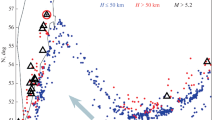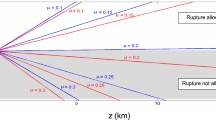Abstract
Variations in characteristics of the seismic process are considered under various thermodynamic conditions. In addition to the usual parameters, differences between hypocenter depths obtained from seismic moment solutions and ordinary hypocentral determinations are considered. Two different tendencies are shown to prevail in source parameter variations for events that occur above and below 80–100 km. The first tendency apparently corresponds to variations in the parameters of ordinary crustal earthquakes with increasing pressure. The second tendency is supposedly associated with the prevalence of specific deep mechanisms of seismogenesis. Distinctions in the dynamics of earthquakes developing downward and toward the surface are examined and accounted for by a low density fluid phase present in earthquake sources. The localization of deep earthquakes at certain depths and specific features of deep seismogenesis are discussed. Such features are related to the role of transformations in the material of subducting plates in the occurrence of deep earthquakes. The problem of genesis of deep earthquakes is discussed.
Similar content being viewed by others
References
K. Abe, “Magnitude, Seismic Moment and Apparent Stress for Major Deep Earthquakes,” J. Phys. Earth, No. 4, 321–330 (1982).
P. W. Bridgman, “Polymorphic Transitions and Geological Phenomena,” Am. J. Sci. A 243(1), 90–96 (1945).
K. E. Bullen, The Earth’s Density (Wiley, New York, 1975; Mir, Moscow, 1978).
C. Christova, “Space Distribution of the Contemporary Stress Field in the Izu-Bonin Wadati-Benioff Zone by Inversion of Earthquake Focal Mechanisms,” J. Geodynamics 39, 413–428 (2005).
J. D. Collier, G. R. Helffrich, and B. J. Wood, “Seismic Discontinuities and Subduction Zones,” Phys. Earth Planet. Int. 127, 35–49 (2001).
J. K. Costain, G. A. Bollinger, and J. A. Speer, “Hydroseismicity: A Hypothesis for the Role of Water in the Generation of Intraplate Seismicity,” Seismol. Res. Lett. 58(3), 41–63 (1987).
B. Efron, Nonconventional Methods of Multivariate Statistical Analysis (Finansy i Statistika, Moscow, 1988) [in Russian].
F. F. Evison, “On the Occurrence of Volume Change at the Earthquake Source,” Bull. Seism. Soc. Am. 56(1), 9–17 (1967).
D. T. Griggs and D. W. Baker, “The Origin of Deep Focus Earthquakes,” in Properties of Matter under Unusual Circumstances (New York, 1968), pp. 23–42.
A. Guest, G. Schubert, and C. W. Gable, “Stresses along a Metastable Wedge of Olivine in a Subducting Slab: Possible Explanation for the Tonga Double Seismic Zone,” Phys. Earth Planet. Int. 141, 253–267 (2004).
T. Ildako and J. Furukawa, “Double Seismic Zone for Deep Earthquakes in the Izu-Bonin Subduction Zone,” Science 263, 1116–1118 (1994).
V. A. Kalinin and M. V. Rodkin, “A Physical Model of Deep Earthquakes,” Izv. Akad. Nauk SSSR, Fiz. Zemli, No. 8, 3–12 (1982).
V. A. Kalinin and M. V. Rodkin, “On the Existence of Quasi-Fault Zones at Great Depths,” in International Symposium “Structure and Dynamics of Transition Zones. Abstracts” (Sochi, 1983), pp. 48–49 [in Russian].
V. A. Kalinin, M. V. Rodkin, and M. A. Danilova, “Analysis and Physical Interpretation of Deep Seismicity in the Kurile-Kamchatka Region,” Izv. Akad. Nauk SSSR, Fiz. Zemli, No. 7, 29–37 (1984).
V. A. Kalinin and M. V. Rodkin, “On the Relation of Faulting Orientations in Deep Earthquake Sources to the Morphology of Benioff Zones,” Izv. Akad. Nauk SSSR, Fiz. Zemli, No. 1, 3–11 (1986).
V. A. Kalinin, M. V. Rodkin, and I. S. Tomashevskaya, Geodynamic Effects of Physicochemical Solid-State Transformations (Nauka, Moscow, 1989) [in Russian].
A. A. Karakin, L. N. Lobkovsky, and V. N. Nikolaevskii, “Formation of the Serpentinitic Layer of the Oceanic Crust and Some Geological-Geophysical Phenomena,” Dokl. Akad. Nauk SSSR, No. 3, 572–576 (1982).
S. Karato, M. R. Riedel, and D. A. Yuen, “Rheological Structure and Deformation of Subducted Slabs in the Mantle Transition Zone: Implications for Mantle Circulation and Deep Earthquakes,” Phys. Earth Planet. Int. 127, 83–108 (2001).
K. Kasahara, Earthquake Mechanics (Cambridge Univ. Press, New York, 1981; Mir, Moscow, 1985) [in Russian].
N. Kato and T. Seno, “Hypocenter Depths of Large Interplate Earthquakes and Their Relation to Seismic Coupling,” Phys. Earth Planet. Int. 210, 53–63 (2003).
D. M. Kerrick and J. A. Connolly, “Metamorphic Devolatilization of Subducted Oceanic Metabasalts: Implication for Seismicity, Arc Magmatism and Volatile Recycling,” Phys. Earth Planet. Int. 189, 19–29 (2001).
I. G. Kissin, “Fluid Saturation, Electrical Conductivity, and Seismicity of the Crust,” Fiz. Zemli, No. 4, 30–40 (1996) [Izvestiya, Phys. Solid Earth 32, 295–303 (1996).
H. Kramer, Mathematical Methods of Statistics (Stockholm, 1946; GIIL, Moscow, 1948) [in Russian].
D. Legrand, D. Villagomez, H. Yepes, and A. Calahorrano, “Multifractal Dimension and b Value Analysis of the 1998–1999 Quito Swarm Related to Guagua Oichincha Volcanic Activity, Ecuador,” J. Geophys. Res. 109, B01 307 (2004).
M. G. Lund and H. Austrheim, “High-Pressure Metamorphism and Deep-Crustal Seismicity: Evidence from Contemporaneous Formation of Pseudotachylytes and Eclogite Facies Coronas,” Tectonophysics 372, 59–83 (2003).
E. Ohtani, K. Litasov, T. Hosoya, et al., “Water Transport into the Deep Mantle and Formation of a Hydrous Transition Zone,” Phys. Earth Planet. Int. 146, 255–269 (2004).
E. A. Okal, “’Detached’ Deep Earthquakes: Are They Really,” Phys. Earth Planet. Int. 127, 109–143 (2001).
S. Omori, T. Komabayashi, and S. Maruyama, “Dehydration and Earthquakes in the Subducting Slab: Empirical Link in Intermediate and Deep Seismic Zones,” Phys. Earth Planet. Int. 146, 297–311 (2004).
E. Orowan, “Mechanism of Seismic Faulting,” in Rock Deformation (New York, 1960), pp. 323–345.
E. M. Riggs and H. W. Green, II, “Shear Localization in Transformation-Induced Faulting: First-Order Similarities to Brittle Shear Failure,” Tectonophysics 340, 95–107 (2001).
M. V. Rodkin, “Hydroseismicity—New Evidence,” J. Geodynamics 15(3–4), 247–260 (1992).
M. V. Rodkin, Geodynamic and Seismotectonic Implications of a Deep Fluid Regime (NGK, Moscow, 1993) [in Russian].
M. V. Rodkin, “Crustal Earthquakes Induced by Solid-State Transformations: A Model and Characteristic Precursors,” J. Earthquake Prediction Res. 4(2), 215–223 (1995).
M. V. Rodkin, “Contradictions in the Recent Seismogenetical Notions,” Phys. Chem. Earth. 21(4), 257–260 (1996/1997).
M. V. Rodkin, “Statistics of Apparent Stresses in Relation to the Origin of an Earthquake Source,” Fiz. Zemli, No. 8, 53–63 (2001) [Izvestiya, Phys. Solid Earth 37, 663–672 (2001)].
M. V. Rodkin, “Seismicity Variations with Depth: New Empirical Relations and Their Interpretation,” Fiz. Zemli, No. 10, 42–53 (2004) [Izvestiya, Phys. Solid Earth 40, 840–848 (2004).
Role of Water in Earthquake Generation Bull. Earth Res. Inst. 76, (3–4, Special Issue) (2001).
G. A. Sobolev, Fundamentals of Earthquake Prediction (Nauka, Moscow, 1993) [in Russian].
D. A. Wiens, “Seismological Constraints on the Mechanism of Deep Earthquakes: Temperature Dependence of Deep Earthquake Source Properties,” Phys. Earth Planet. Int. 127, 145–163 (2001).
D. Zhao, “Seismological Structure of Subduction Zones and Its Application for Arc Magmatism and Dynamics,” Phys. Earth Planet. Int. 127, 197–214 (2001).
D. Zhao, “Global Tomographic Images of Mantle Plumes and Subducting Plates: Insight into Deep Earth Dynamics,” Phys. Earth Planet. Int. 146, 3–34 (2004).
D. Zhao, M. Tani, and O. P. Mishra, “Crustal Heterogeneity in the 2000 Western Tottori Earthquake Region: Effect of Fluids from Slab Dehydration,” Phys. Earth Planet. Int. 145, 161–177 (2004).
Author information
Authors and Affiliations
Additional information
Original Russian Text © M.V. Rodkin, 2006, published in Fizika Zemli, 2006, No. 9, pp. 29–39.
Rights and permissions
About this article
Cite this article
Rodkin, M.V. Implications of differences in thermodynamic conditions for the seismic process. Izv., Phys. Solid Earth 42, 745–754 (2006). https://doi.org/10.1134/S1069351306090047
Received:
Issue Date:
DOI: https://doi.org/10.1134/S1069351306090047




